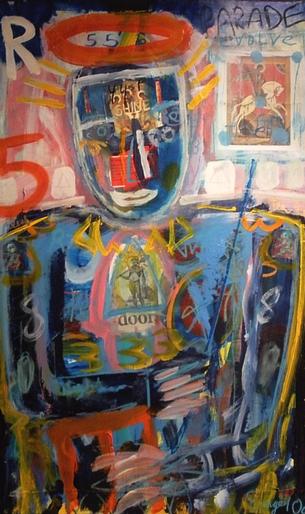
In his new exhibition at the Romany Kramoris Gallery in Sag Harbor, Chris Engel continues in his recent works an exploration into Jungian themes of mysticism, religion, self-awareness, and the impact on humanity of what Jung called the collective unconscious, sometimes called the collective subconscious.
Titled “Angels and Prophets: Part 1” (even though the exhibit is the third installment of a trilogy preceded by “Ancestors” and “Madrigals”), the exhibition features works that offer an energetic mix of both surreal and expressionistic influences, as seen in the use of literary and figurative elements generating narrative overtones absent any immediate prompting or overt clues as to meaning within the works.
Manifesting Jung’s beliefs in “Automatism,” in which the importance of psychological spontaneity transcends conscious control, Mr. Engel conjures mystical premonitions, apparitional communications, and mythical references to personal and spiritual iconography in his application of vivid figuration, exuberant coloration, and calligraphic and literary references.
Interestingly, while it was Sigmund Freud who, amid the 21st century’s developing reverence for science and the quest for rational knowledge, somewhat unintentionally spurred artistic interest in the metaphysical realm, it was his protégé, Carl Jung, whose studies had the more immediate impact on the arts.
Cautioning that science and logic only went so far in determining a measure of understanding and self-awareness, Jung’s studies ended up profoundly influencing both the surrealist and the expressionist painters from whom Mr. Engel takes his most immediate cues.
The artist employs a compositional approach that simultaneously flattens the overall structure while still hinting at a sense of depth beyond the occasionally frenetic mix of images, colors, and calligraphy that occupy the picture plane. The effect he achieves is a rather dreamlike ambiance that is simultaneously bristling with an emotional undercurrent of energy, highlighted by the artist’s vigorous use of line and hue, each seemingly balanced against the other. In combination they express, as Jung once wrote, that “the greater the tension, the greater is the potential. Great energy springs from a correspondingly great tension of opposites.”
This aspect of energy is further enhanced by the manner in which the artist has installed the works, which—in combination with the rather entertainingly eclectic mix of objects in the gallery itself—adds to their thematic interactions.
Numerology, presumably as a product of a sort of spiritual and mystical divination, is also a prominent element in this series. Its introduction serves on a superficial level as a rhythmic component that seems almost literally to orchestrate the composition, while, in a metaphysical sense, it further underscores the Jungian principles of human consciousness as expressed by the physical awareness of sensation, feeling, thinking, and intuition.
Of particular interest in the exhibition is “Angels and Prophets” which uses a dramatic juxtaposition of line and color both to complement and to accentuate the figures that dominate the composition. But it is the introduction of numbers and digits dotting the surface that creates both mysterious patterns in their placement as well as allowing certain psychological harmonies to develop in the ambiguous interaction of meaning and symbolism.
This effect is further emphasized in this work by the sideways number 8 in the upper left quadrant, a double entendre in terms of the authority of the number itself (within the study of numerology the most powerful) as well as also representing the mathematical symbol for infinity.
Poetic elements also figure prominently in a number of the works, especially “Howl,” which includes not only a reference to the poem of the same name and the madman for whom it was written, but also refers to the French novelist Andre Gide, whose work revolved around the investigation of personal freedom and the constraints of moralistic and puritan social restrictions.
The exhibition of recent works by Chris Engel, “Angels and Prophets: Part 1,” continues at the Romany Kramoris Gallery in Sag Harbor through January 4.